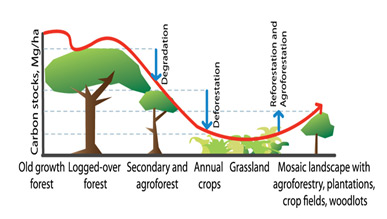
- PMRV
- Activities
- RS/GIS
- Introduction
Introduction
Geographic information systems (GIS) and remote sensing have been widely used over the last three decades to assess tropical deforestation. Measurement of forest degradation however remains a challenging task due to the complexity of the ecosystem. Recent development of satellite data with finer resolution (50 cm – 10 m) has made the assessment of forest degradation possible under certain conditions. The extent of degradation, typically caused by selective logging and fuel wood/charcoal production, harvesting of non-timber forest products (NTFPs), change in net primary productivity (NPP), has different impacts on forests. Depending on the scale of disturbance and the spatial- and temporal-resolution of satellite data, analysis of degraded forests can be conducted with reasonable accuracy.
But what are we doing beyond that?
We are developing a GIS and remote sensing based approach for mapping and monitoring forest change, and are involving local communities in the mapping and monitoring processes. One challenge is how to combine biophysical data from satellite data analysis with socio-economic data from household surveys and key stakeholder interviews. Another challenge is to estimate deforestation and forest degradation events that have occurred in project sites in which different stages of forest transition have been identified.

Forest and Land Use Transition Curve
(Source: CGIAR Research Program 6 on Forests, Trees and Agroforestry, CIFOR.)
The main objectives of our work are to develop a relatively simple and cost-effective method of applying satellite images and spatial data, and to verify them with credible information from participatory collection of information on land use and land cover change. Another focus of the study is to identify the drivers of deforestation and forest degradation, and the resulting impacts.
In short, our activities consist of satellite imagery analysis, ground checks and linking the results of our remote sensing analysis to the results of the social study.


